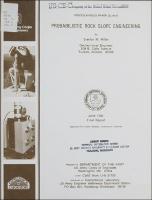Please use this identifier to cite or link to this item:
https://hdl.handle.net/11681/10244Full metadata record
| DC Field | Value | Language |
|---|---|---|
| dc.contributor.author | Miller, S. M. (Stanley M.) | - |
| dc.date.accessioned | 2016-06-20T13:53:39Z | - |
| dc.date.available | 2016-06-20T13:53:39Z | - |
| dc.date.issued | 1984-06 | - |
| dc.identifier.uri | http://hdl.handle.net/11681/10244 | - |
| dc.description | Miscellaneous Paper | - |
| dc.description | Abstract: Natural variabilities in rock mass properties and uncertainties in their measurement and estimation imply the probabilistic nature of parameters required for rock slope engineering. Therefore, statistical and probabilistic methods are important for studying mapped fracture data, analyzing rock strength testing data, and evaluating rock slope stability. Such methods provide a realistic treatment of parameter variabilities and lead to probabilistic slope design criteria. Rock slope engineering requires information about geologic structures because slope failures in rock masses commonly occur along structural discontinuities. Stability of rock slopes is primarily governed by the geometric properties and shear strengths of geologic discontinuities and also by the local stress field. Natural variabilities in these rock mass properties and uncertainties in their measurement and estimation imply the probabilistic nature of input parameters needed for rock slope engineering. In a probabilistic slope stability analysis the input parameters are considered as random variables that must be statistically described. The descriptive process relies on statistical analyses of discontinuity data collected by field mapping and of laboratory and field test results. Sound geologic and engineering judgement should be used in conjunction with these analyses. The probability of stability for a given slope failure mode is estimated by combining the probability of sliding and the probability that the potential sliding surface is long enough to allow failure. The probability of sliding is calculated from a safety factor distribution which can be estimated by Monte Carlo simulation or by numerical convolution performed by discrete Fourier procedures. The probability of sifficient length is estimated from discontinuity length data obtained by structure mapping. Multiple occurrences of the same failure mode in a slope can be analyzed after they have been simulated by generating spatially correlated properties of discontinuities responsible for the failure mode. A probabilistic analysis also allows for the effects of different failure modes in the same slope to be combined into a probabilistic estimate of overall slope stability. Thus, rock slope engineering can be enhanced by probabilistic methods that allow for a realistic treatment of parameter variabilities and multiple failure modes and that also produce useful probabilistic slope design criteria. | - |
| dc.publisher | Geotechnical Laboratory (U.S.) | - |
| dc.publisher | Engineer Research and Development Center (U.S.) | - |
| dc.relation | http://acwc.sdp.sirsi.net/client/en_US/search/asset/1042008 | - |
| dc.relation.ispartofseries | Miscellaneous paper (U.S. Army Engineer Waterways Experiment Station) ; GL-84-8. | - |
| dc.rights | Approved for public release; distribution is unlimited. | - |
| dc.source | This Digital Resource was created from scans of the Print Resource | - |
| dc.subject | Rock slopes | - |
| dc.subject | Rock mechanics | - |
| dc.subject | Slope stability | - |
| dc.subject | Probabilities | - |
| dc.subject | Statistical methods | - |
| dc.subject | Structural geology | - |
| dc.title | Probabilistic rock slope engineering | - |
| dc.type | Report | en_US |
| Appears in Collections: | Miscellaneous Paper | |
Files in This Item:
| File | Description | Size | Format | |
|---|---|---|---|---|
| MP-GL-84-8.pdf | 12.71 MB | Adobe PDF |  View/Open |